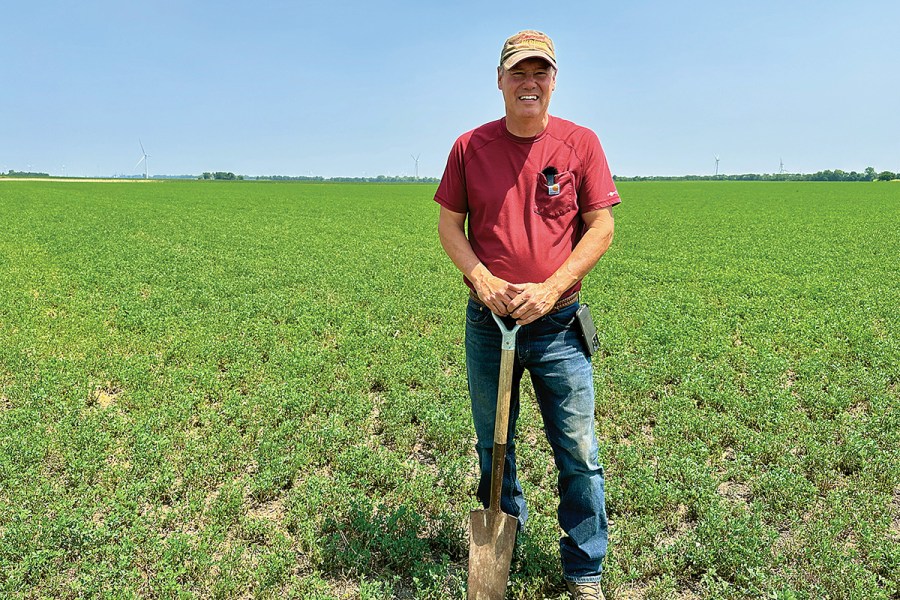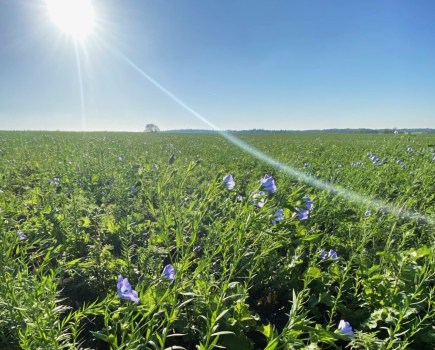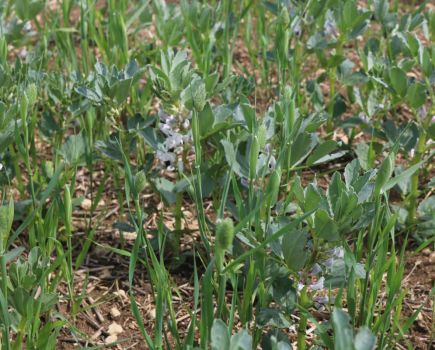Combining no-till and organic in a single farming system at scale seems virtually impossible to many, but US regen farmer Rick Clark is showing it can be done. CPM paid him a visit.
“I have to be careful not to paint a nice rosy picture because going organic with no tillage is extremely difficult.”
By Mike Abram
It’s just after noon in late June and the sun is beating down on a 33oC day when CPM walks into a field with a slightly nervous Rick Clark in west central Indiana.
He’s been away from the farm for a week on business in Canada and this is the first chance he’s had to walk some fields. First on the list is a field of milo (grain sorghum), which he drilled two weeks previously.
Will it have emerged or even still be alive, he ponders. “We’ve had no rain for eight weeks, and it sure is dry.”
Opening a drill slot he finds what he’s looking for – a small red seed with a shoot that hasn’t quite emerged through the surface. “There’s one growing right there,” he says, with some relief. “It’s alive and well and has put down a decent root; it has enough moisture. We could do with some rain but I like the way this looks.”
He scans across the field which last year was soya beans into which he planted an overwintered cover crop before drilling the milo into the residue.
“We have the armour,” he says, talking about how the cover crop residue is protecting the soil surface from the elements. He starts digging through the surface with his spade.
“And look at how I can get that spade into the ground. See, there’s still an earthworm and we haven’t had any rain for weeks,” he says, excitedly. “It still feels cool and moist – it’s incredible how much moisture there is – you won’t have that on most farms [around here].”
He’s right, his farm is different in many ways from others you drive past in the area, and in reality, from most farms anywhere in the world. That’s because Rick is combining two types of farming which many think might be the Holy Grail, but are almost mutually exclusive at scale – zero tillage and organic.
It’s been an 18-year journey to reach this point. “I have to be careful not to paint a nice rosy picture because going organic with no tillage is extremely difficult,” he stresses. “You require patience and a financial position that’s strong because you’ll have yield setbacks. I’ve experienced all of that.”
Soil erosion was his trigger for the start of a transition across the 2800ha farm, which until then had mostly been farmed conventionally using a lot of tillage and chemicals.
“We tilled the ground for corn (maize) in the autumn. If the fields weren’t black, meaning if you could see residue, you tilled again until you couldn’t see any residue. Then in the spring you’d come out a few days before planting and run a shallow tillage to open the crust and let Mother Nature dry the fields out,” he explains.
“Then maybe you’d come back three hours later and work again a little deeper to 5cm, before coming back the next day to plant corn. Well this time, we had an unexpected 1” (2.5cm) rain event. The field had a 1% slope, which is nothing. So we go out to plant and coming down the road the field doesn’t look right, the ditch doesn’t look right.
“It isn’t green, it’s dark, and the closer I get I’m like – oh, the field has moved. It’s eroded into the ditch and onto the road. That’s when it hit me – this is crazy. We have to do something different.”
After researching various options, Rick opted to plant tillage radish as a cover crop ahead of corn, which as well as binding soil would mitigate compaction with its deep tap root and be killed over winter by frosts.
It left him able to direct drill corn, something he hadn’t done up to then. Other inputs were left as previously. The result was the highest yielding corn field on the farm that year, which had the best return on investment as tillage costs had been removed.
“And I’m like, this is a big deal! But is it a fluke? I’m going to try again,” recalls Rick. “The next year we tried 200ha with the same results, and now I’m in.”
That core approach of testing something and then expanding it over his area when he’s proved it works, combined with good fortune at the right time, has been central to his onward journey. It also helps that he has a healthy disregard for agricultural norms, preferring to challenge rather than follow conventional wisdom.
It was how he started ‘farming green’ – the practice of drilling directly into cover crops rather than terminating them weeks before, and what’s subsequently become his social media calling card and name of his podcast.
“I was reading a magazine article which said don’t plant corn into autumn-established cereal rye,” he explains. “That was enough motivation to try it, but not on just 80ha, but on 600ha.”
Conventional wisdom was to terminate the cover well before planting corn, but his gut was telling him to not terminate it until after he’d planted the cash crop.
“At the time I don’t know why this was important,” he admits. But again, Mother Nature played an important hand in finding out why with rain preventing him from spraying off the cereal rye for six weeks after planting.
In that time, the cereal rye had grown to well over a 1m tall, while the maize was an elongated 30cm for the growth stage and ‘brightest colour of yellow you could imagine’.
Instead of writing it off as a failure, he persevered, applying around 30kgN/ha which had an immediate greening effect on the Roundup Ready maize. After finally spraying off the cereal rye with glyphosate, another application of liquid UAN, it was eventually the best performing field of maize on the farm, say Rick.
“It’s because there are tremendous amounts of nutrients in these cover crops,” he explains. Follow up tests proved that the following season where he took samples of the rye, both as it was growing and post-termination. “At termination, there was 290kg/ha of potash and two months later we were below 60kg/ha, so it’d exhausted that potash back into the soil profile to be taken in by the following crop.”
He then started to look at reducing fertiliser inputs. “I picked a corn field and a soya bean field and sat down with my agronomist and told him I wanted him to make his normal recommendation, and then we were going to cut the inputs in half. On all the other fields we did our normal system.”
Again, he didn’t find much difference in yields, while soil nutrient tests taken before and after the crop also showed little difference. “We just raised a crop that’s equal to the rest of the farm, with reduced fertilisers.”
The next year he cut the fertiliser by another half, so now a 75% reduction, on the first two fields, and then cut by 50% on another 200ha. They tested the same, he says. “I did it one more time. The first field with zero fertiliser; the second 200ha with another 50% cut. The fields with zero actually showed an increase in nutrients after the crop in the soil tests and yielded the same as the rest of the farm.
“I’m done, I said. We’re taking fertiliser away, so we implemented a 50% reduction across the rest of the farm, then a 70% reduction. That was the point we were maximising our return on investment on the farm – 100% no-till, 100% cover crop, 70% reduction of inputs and 100% non-GMO, and we stayed like that for a couple of years.”
GMO crops had been removed during the intervening period after a local dairy farm asked him to grow 600ha of non-GMO corn. The dairy supplied Danone, which was looking to produce non-GMO yoghurt in North America.
In the first year, he used insecticide on most of the area but left a couple of check strips without which showed no yield decrease, so not only did he stop growing GMO crops, he also removed insecticides from his system.
One of the last inputs to be eliminated was post-emergence herbicides in soya beans. Dr Erin Silva, a researcher with an interest in organic no-till at the University of Wisconsin, Madison, was the inspiration with a field day about planting beans into cereal rye at booting, and 45 days later rolling them down with a crimper roller.
“In 40 days the rye will be flowering and that’s when lignin is highest in the plant and most vulnerable to being laid flat with a crimper roller,” explains Rick.
As long as the beans aren’t past V3, they’ll stand back up while the rye becomes a mulch to suppress weeds. Check strips, when Rick implemented it at home, showed it worked.
“The beans were beautiful, and they yielded. Yes, there were some weeds, but for the most part it was under control.”
This success was the final step for Rick to ask himself why he wasn’t organic? “But I didn’t want to be a farmer that farms in the traditional organic way with high tillage, it’s mass destruction of the soil,” he says.
So his system relies on high biomass cover crops for 70% of the weed control with the other 30% coming from competition from the cash crop.
Driving around the farm it was possible to see both the success and some of the weaknesses in that approach. In large areas weed control is good enough, but there are concerning patches of thistles and chicory in some cereal fields. Like all considered farmers, Rick is already thinking about how to manage them effectively.
“My first swing will be to come in with a milo crop right after harvest if we have rain. That should help smother the thistles out during the off season. If we still have thistles next year, I’ll go to alfalfa. Two years of alfalfa, cut five times a year, and this will be gone,” he hopes.
Milo is becoming an important crop for Rick. His first 120ha was certified organic in June 2019, with the rest of the area certified in a couple of much bigger parcels subsequently. But what he’s discovering is that growing organic corn is a challenge.
“I’ve come to the realisation that maybe we’re trying to grow the wrong things. Maybe corn isn’t intended to be grown in a no-till organic regenerative environment, so we’re moving into milo. It’s a cousin to corn, but it doesn’t care who its neighbours are. Corn is a wimp, it has to have everything perfect. I’m not giving up on corn, but I’m spreading my risk.”
Another crop he’s trying to incorporate is peas. He’s trialling a couple of different ways. One is a winter-tolerant pea which has been planted into buckwheat stubble in the autumn along with a cover crop. That was flail chopped in the spring before planting milo.
Secondly, a spring pea was planted into an overwinter cover crop in early May with corn planted about a week later. Again, the cover crop is flailed to create a weed suppressing mulch with the hope that in both cases around 50kg/ha of nitrogen will become available for the cash crop.
The financial savings from his system have been considerable (see table). What’s now effectively a three-pass system across a large area means a 50% saving on diesel, a 64% reduction in horsepower requirements, and significant input savings – nearly £400,000 on pesticides and over £1M on fertilisers. In total, it adds up to more than $2M (£1.56M) a year, he concludes.
This article was taken from the latest issue of CPM. Read the article in full here.
For more articles like this, subscribe here.
Sign up for Crop Production Magazine’s FREE e-newsletter here.




